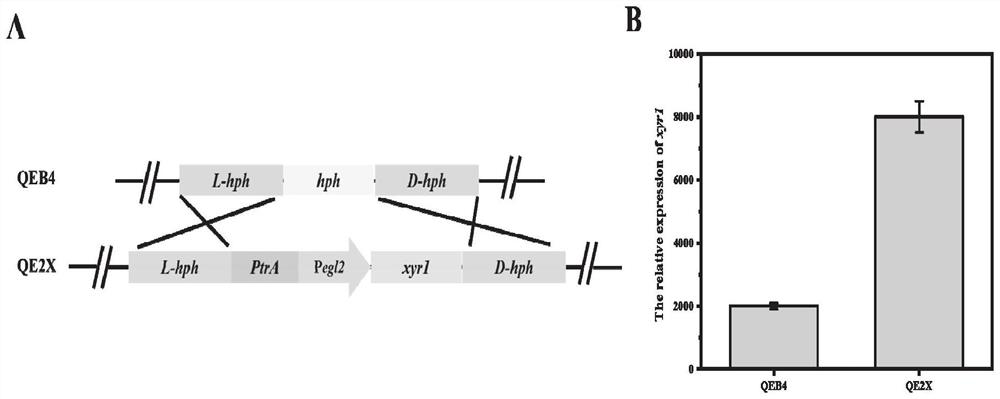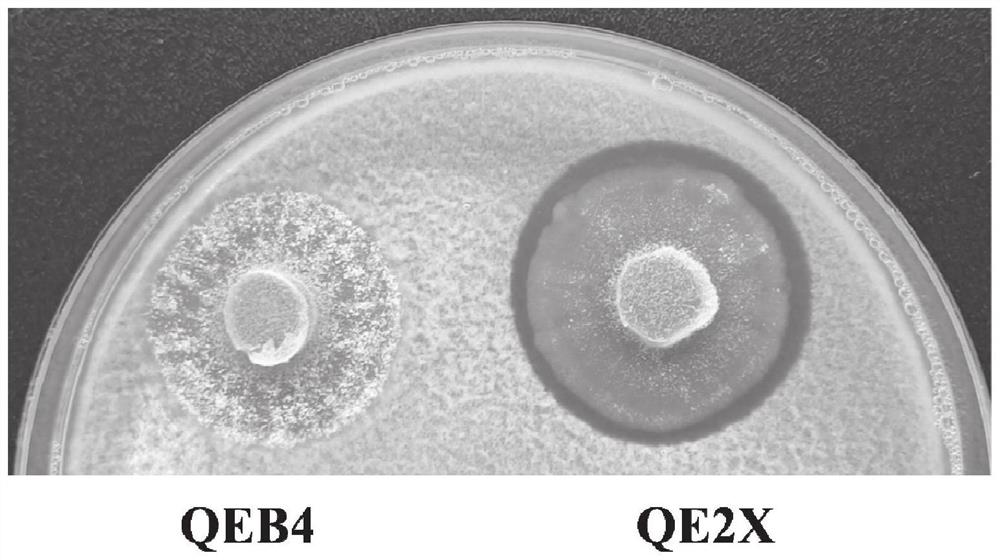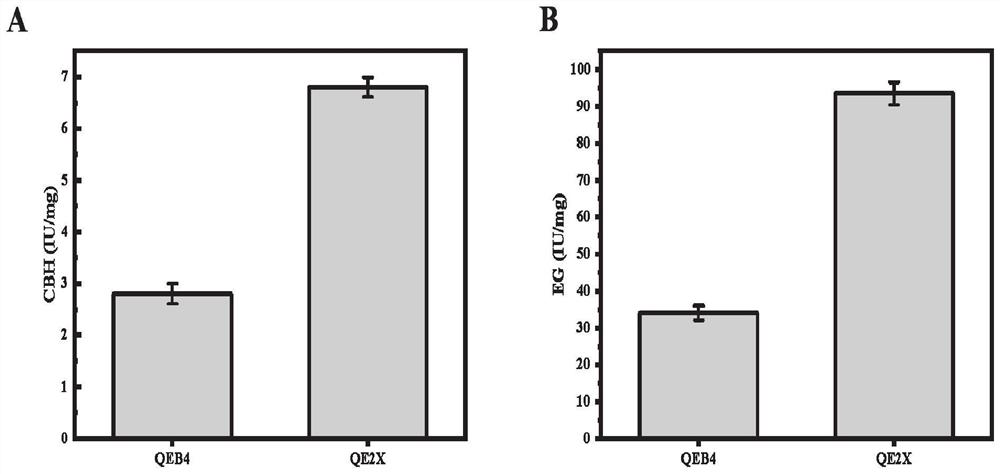Method for improving activity of trichoderma reesei cellulose hydrolase by using cellulose inducible promoter
A technology of cellulolytic enzyme and Trichoderma reesei, applied in the field of genetic engineering, can solve the problems such as the inconspicuous promotion effect of β-glucosidase, achieve good industrial development and application prospects, increase production, fermentation time cost and economy The effect of cost reduction
- Summary
- Abstract
- Description
- Claims
- Application Information
AI Technical Summary
Problems solved by technology
Method used
Image
Examples
Embodiment 1
[0032] Example 1. Construction of an overexpression cassette for the transcriptional regulator xyr1.
[0033] Using the genomic DNA of Trichoderma reesei QEB4 as a template, use the primer pair Egl2-F / Egl2-R to amplify the cellulose inducible promoter Pegl2 (its nucleotide sequence is shown in SEQ ID NO.1), use the primer pair Xyr1-F / Xyr1-R amplifies the xyr1 gene and its terminator region, uses the primer pair Hph-UF / Hph-UR and Hph-DF / Hph-DR to amplify the upstream and downstream homology arms of the hph gene; and uses the primer pair ptrA-F1 / ptrA-R1 amplifies the ptrA expression cassette from the T-ptrA plasmid. Then, the upstream homology arm of the hph gene, the resistance genes prtA, Pegl2, xyr1 gene and terminator, and the downstream homology arm of the hph gene are fused. The fusion PCR program is: Buffer enzyme 25 μl, dNTP 1 μl, Phata enzyme 1 μl, fragment A total of 5 μg with ddH 2 Make up 50 μl with O; the fusion program is: pre-denaturation at 95°C for 5 minutes, ...
Embodiment 2
[0045] Embodiment 2. Utilize Pegl2-xyr1 overexpression cassette to transform Trichoderma reesei QEB4 strain to construct high cellulolytic enzyme active Trichoderma reesei engineering strain
[0046] Genetic transformation of Trichoderma reesei QEB4 using PEG / CaCl 2 Mediated protoplast transformation method, pyrithione resistance gene ptrA as selectable marker.
[0047] The purified Pegl2-xyr1 overexpression cassette was transformed into Trichoderma reesei QEB4 protoplasts to construct the engineering strain QE2X of Trichoderma reesei with high cellulolytic activity. Wherein the PEG / CaCl 2 The specific method of mediated protoplast transformation is as follows:
[0048] (1) Preparation of Trichoderma reesei QEB4 protoplast:
[0049] Prepare fresh Trichoderma reesei spores (within 2 weeks), spread on 5-6 PDA plates covered with cellophane, and spread 150 μL on each plate with a concentration of 10 8 individual / mL spore suspension. Incubate at 32°C for 14 hours. After the m...
Embodiment 3
[0058] Example 3. Transcription level analysis of the cellulase transcription regulator xyr1 gene of high cellulolytic enzyme activity Trichoderma reesei engineering strain
[0059] The high cellulolytic enzyme activity Trichoderma reesei engineering strain QE2X that embodiment 2 obtains and starting strain QEB4 press 10 8 Each / mL were inoculated into 50mL (250mL Erlenmeyer flask) seed medium respectively, and after 40 hours of shaking flask culture, 10mL were respectively inoculated into the fermentation medium, 32°C, 220rpm shaking flask cultured for 72h, and the mycelium was collected by suction filtration RNA was extracted and analyzed by reverse transcription qPCR. The result is as figure 2 As shown in A, it shows that the transcription of xyr1 in QE2X is significantly increased, which is 4 times higher than that of the starting strain. It further showed that the Pegl2-xyr1 overexpression cassette was successfully integrated into the genome and xyr1 was expressed at a ...
PUM
 Login to View More
Login to View More Abstract
Description
Claims
Application Information
 Login to View More
Login to View More - R&D
- Intellectual Property
- Life Sciences
- Materials
- Tech Scout
- Unparalleled Data Quality
- Higher Quality Content
- 60% Fewer Hallucinations
Browse by: Latest US Patents, China's latest patents, Technical Efficacy Thesaurus, Application Domain, Technology Topic, Popular Technical Reports.
© 2025 PatSnap. All rights reserved.Legal|Privacy policy|Modern Slavery Act Transparency Statement|Sitemap|About US| Contact US: help@patsnap.com



